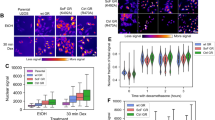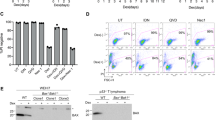Abstract
Glucocorticoid hormones induce apoptosis in lymphoid cells. This process is transcriptionally regulated and requires de novo RNA/protein synthesis. However, the full spectrum of glucocorticoid-regulated genes mediating this cell death process is unknown. Through gene expression profiling we discovered that the expression of thioredoxin-intereacting protein (txnip) mRNA is significantly induced by the glucocorticoid hormone dexamethasone not only in the murine T-cell lymphoma line WEHI7.2, but also in normal mouse thymocytes. This result was confirmed by Northern blot analysis in multiple models of dexamethasone-induced apoptosis. The induction of txnip mRNA by dexamethasone appears to be mediated through the glucocorticoid receptor as it is blocked in the presence of RU486, a glucocorticoid receptor antagonist. Deletion and mutation analysis of the txnip promoter identified a functional glucocorticoid response element in the txnip promoter. Reporter assays demonstrated that this glucocorticoid response element was necessary and sufficient for induction of txnip by dexamethasone. Expression of a GFP-TXNIP fusion protein was sufficient to induce apoptosis in WEHI7.2 cells, and repression of endogenous txnip by RNA interference inhibited dexamethasone-induced apoptosis in WEHI7.2 cells. Together, these findings indicate that txnip is a novel glucocorticoid-induced primary target gene involved in mediating glucocorticoid-induced apoptosis.
This is a preview of subscription content, access via your institution
Access options
Subscribe to this journal
Receive 50 print issues and online access
$259.00 per year
only $5.18 per issue
Buy this article
- Purchase on Springer Link
- Instant access to full article PDF
Prices may be subject to local taxes which are calculated during checkout










Similar content being viewed by others
Change history
21 February 2008
An Erratum to this paper has been published: https://doi.org/10.1038/sj.onc.1211001
References
Ashwell JD, Lu FW, Vacchio MS . (2000). Annu Rev Immunol 18: 309–345.
Baker A, Payne CM, Briehl MM, Powis G . (1997). Cancer Res 57: 5162–5167.
Butler LM, Zhou X, Xu WS, Scher HI, Rifkind RA, Marks PA et al. (2002). Proc Natl Acad Sci USA 99: 11700–11705.
Cairns C, Gustafsson JA, Carlstedt-Duke J . (1991). Mol Endocrinol 5: 598–604.
Chapman MS, Askew DJ, Kuscuoglu U, Miesfeld RL . (1996). Mol Endocrinol 10: 967–978.
Chauhan D, Auclair D, Robinson EK, Hideshima T, Li G, Podar K et al. (2002). Oncogene 21: 1346–1358.
Chen KS, DeLuca HF . (1994). Biochim Biophys Acta 1219: 26–32.
Cohen JJ, Duke RC . (1984). J Immunol 132: 38–42.
Dieken ES, Miesfeld RL . (1992). Mol Cell Biol 12: 589–597.
Han SH, Jeon JH, Ju HR, Jung U, Kim KY, Yoo HS et al. (2003). Oncogene 22: 4035–4046.
Harmon JM, Norman MR, Fowlkes BJ, Thompson EB . (1979). J Cell Physiol 98: 267–278.
Helmberg A, Auphan N, Caelles C, Karin M . (1995). EMBO J 14: 452–460.
Jondal M, Pazirandeh A, Okret S . (2004). Trends Immunol 25: 595–600.
Junn E, Han SH, Im JY, Yang Y, Cho EW, Um HD et al. (2000). J Immunol 164: 6287–6295.
Kim KY, Shin SM, Kim JK, Paik SG, Yang Y, Choi I . (2004). Biochem Biophys Res Commun 315: 369–375.
Malone MH, Wang Z, Distelhorst CW . (2004). J Biol Chem 279: 52850–52859.
Minn AH, Hafele C, Shalev A . (2005). Endocrinology 146: 2397–2405.
Mullick J, Anandatheerthavarada HK, Amuthan G, Bhagwat SV, Biswas G, Camasamudram V et al. (2001). J Biol Chem 276: 18007–18017.
Nishinaka Y, Masutani H, Nakamura H, Yodoi J . (2001). Redox Rep 6: 289–295.
Nishiyama A, Matsui M, Iwata S, Hirota K, Masutani H, Nakamura H et al. (1999). J Biol Chem 274: 21645–21650.
Nordeen SK, Suh BJ, Kuhnel B, Hutchison CD . (1990). Mol Endocrinol 4: 1866–1873.
Oberg HH, Sipos B, Kalthoff H, Janssen O, Kabelitz D . (2004). Cell Death Differ 11: 674–684.
Park CG, Lee SY, Kandala G, Choi Y . (1996). Immunity 4: 583–591.
Planey SL, Abrams MT, Robertson NM, Litwack G . (2003). Cancer Res 63: 172–178.
Powis G, Montfort WR . (2001). Annu Rev Biophys Biomol Struct 30: 421–455.
Prefontaine GG, Lemieux ME, Giffin W, Schild-Poulter C, Pope L, LaCasse E et al. (1998). Mol Cell Biol 18: 3416–3430.
Qian N, Frank D, O'Keefe D, Dao D, Zhao L, Yuan L et al. (1997). Hum Mol Genet 6: 2021–2029.
Ramdas J, Harmon JM . (1998). Endocrinology 139: 3813–3821.
Reichardt HM, Kaestner KH, Tuckermann J, Kretz O, Wessely O, Bock R et al. (1998). Cell 93: 531–541.
Rho J, Gong S, Kim N, Choi Y . (2001). Mol Cell Biol 21: 8365–8370.
Saitoh T, Tanaka S, Koike T . (2001). J Neurochem 78: 1267–1276.
Schmidt S, Rainer J, Ploner C, Presul E, Riml S, Kofler R . (2004). Cell Death Differ 11(Suppl 1): S45–55.
Schoneveld OJ, Gaemers IC, Lamers WH . (2004). Biochim Biophys Acta 1680: 114–128.
Thompson EB . (1998). Steroids 63: 368–374.
Tome ME, Baker AF, Powis G, Payne CM, Briehl MM . (2001). Cancer Res 61: 2766–2773.
Tonomura N, McLaughlin K, Grimm L, Goldsby RA, Osborne BA . (2003). J Immunol 170: 2469–2478.
Torres-Roca JF, Tung JW, Greenwald DR, Brown JM, Herzenberg LA, Katsikis PD . (2000). J Immunol 165: 4822–4830.
Truss M, Chalepakis G, Beato M . (1990). Proc Natl Acad Sci USA 87: 7180–7184.
Wang R, Zhang L, Yin D, Mufson RA, Shi Y . (1998). J Immunol 161: 2201–2207.
Wang Y, De Keulenaer GW, Lee RT . (2002). J Biol Chem 277: 26496–26500.
Wang Z, Malone MH, He H, McColl KS, Distelhorst CW . (2003a). J Biol Chem 278: 23861–23867.
Wang Z, Malone MH, Thomenius MJ, Zhong F, Xu F, Distelhorst CW . (2003b). J Biol Chem 278: 27053–27058.
Webb MS, Miller AL, Johnson BH, Fofanov Y, Li T, Wood TG et al. (2003). J Steroid Biochem Mol Biol 85: 183–193.
Wyllie AH . (1980). Nature 284: 555–556.
Wyllie AH, Morris RG, Smith AL, Dunlop D . (1984). J Pathol 142: 67–77.
Yamawaki H, Pan S, Lee RT, Berk BC . (2005). J Clin Invest 115: 733–738.
Acknowledgements
We thank Michael Sramkowski and Tammy Stefan for assistance with flow cytometry. This work was supported by NIH Grants RO1 CA42755 (CWD), T32 CA59366 (MHM) and T32 HL07147 (MCD). Also, this research was supported by the flow cytometry core facility of the Case Comprehensive Cancer Center (CP30 CA43703).
Author information
Authors and Affiliations
Corresponding author
Rights and permissions
About this article
Cite this article
Wang, Z., Rong, Y., Malone, M. et al. Thioredoxin-interacting protein (txnip) is a glucocorticoid-regulated primary response gene involved in mediating glucocorticoid-induced apoptosis. Oncogene 25, 1903–1913 (2006). https://doi.org/10.1038/sj.onc.1209218
Received:
Revised:
Accepted:
Published:
Issue Date:
DOI: https://doi.org/10.1038/sj.onc.1209218
Keywords
This article is cited by
-
In the absence of apoptosis, myeloid cells arrest when deprived of growth factor, but remain viable by consuming extracellular glucose
Cell Death & Differentiation (2019)
-
Oxidation of Atg3 and Atg7 mediates inhibition of autophagy
Nature Communications (2018)
-
Thioredoxin-Interacting Protein (TXNIP) in Cerebrovascular and Neurodegenerative Diseases: Regulation and Implication
Molecular Neurobiology (2018)
-
Different levels of various glucocorticoid-regulated genes in corticotroph adenomas
Endocrine (2013)
-
Involvement of thioredoxin-interacting protein (TXNIP) in glucocorticoid-mediated beta cell death
Diabetologia (2012)



